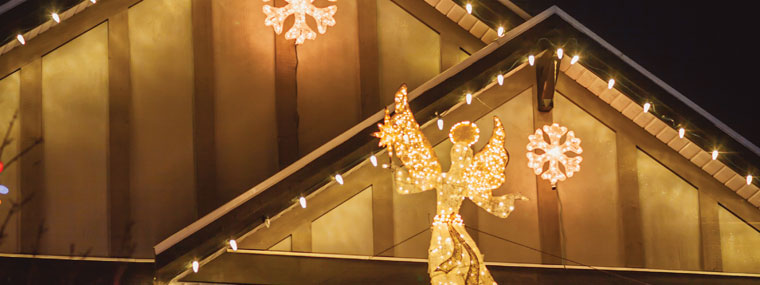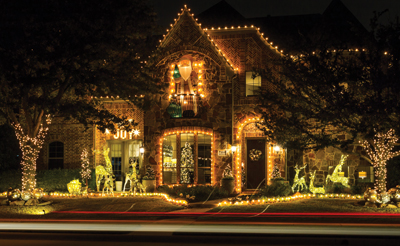
Getting Started with Christmas Lights
By Diane M. Calabrese / Published October 2023

Illumination, radiance, celestial…lovely words convey the many meanings of light.
How could it be otherwise? Thanks to the planet’s unique position in our solar system, the sun nourishes life on Earth.
That’s a literal and figurative nourishment with photosynthesis providing food and light igniting our spirit. Few people don’t welcome a clear and sunny day.
No surprise, then, that lights are used not only to brighten dark days and nights but also to add to what is already a festive occasion. Christmas and lights are the most natural of fits.
From candles to incandescent bulbs to LEDs, light sources have long been tapped to celebrate the promise and the beauty of Christmas. As the interest in outdoor lighting has increased, so too have the opportunities for contractors who can install and uninstall lighting for homeowners.
Of course, it’s not just residential customers who look for capable light installers these days, but also commercial building owners and communities. At the same time, outdoor lighting to celebrate special days or add ambience to any nighttime setting may be installed even in summer.
True enough that when one reviews the websites of power washing contractors, ever more list installing Christmas lights as a service. Concern about market saturation is misplaced, though—misplaced because demonstrating and refining capability with Christmas lights for residential customers leads to other opportunities: commercial and community clients, lighting for events, etc.
But we don’t need to start with the opportunity for growth because currently prospective clients outnumber the contractors ready to meet their needs. One reason for that is the compressed time interval for installation of Christmas lights, an interval that’s not subject to change.
“There is so much work and such a small amount of time that not all companies can service it all,” says Pat Clark, Precision Pro Wash in Duncan, SC. The Greenville, SC, area, which Clark’s company serves, is growing in population at the rate of 2.5 percent each year; it had more than 72,000 residents in 2021.
If a particular market is saturated, a contractor can boost the number of clients by offering a combination of services. “Gutter guards are a great add on,” says Clark, who installs RainDrop® Gutter Guards.
Naturally, contractors working in regions with significant snow-fall may be limited regarding gutter guards. But there are other options. Some contractors do snow removal in winter. Selling Christmas light installation with snow removal services can make a good package.
Should lighting installation be a service offered beyond the Christmas season, such as for parties or outdoor weddings? “It definitely can be, depending on how busy a contractor stays in washing,” says Clark. “Or hire more people for the lighting.”
As for the most challenging dimensions of getting involved with lighting, two top the list. “Takedown is the hardest,” says Clark. “You need a system for takedown so the next year it’s faster.” An “inventory process” is also needed.
Like any endeavor, preparation and training are necessary. Contractors who may be getting started with Christmas lights should know about CLIPA [Christmas Light Installation Pros Association], which is based in California.
“I think an important question to ask when taking any type of training is what qualifies the trainer as an expert in the field,” says Matt Hyden, the president of CLIPA. “Pertaining to us, all of our trainers currently own and operate their own installation companies, and all are doing over seven figures in their Christmas lighting business.”
As for experience, CLIPA can attest to it. “We have a combined total of over 40 years of experience and are still actively installing, which allows us to keep up to date on the latest products and practices in the industry,” says Hyden.
CLIPA members have broad experience. “Many of our members not only offer other service-related business but also add on other lighting services, such as permanent lighting, patio lighting, and bistro lighting,” says Hyden.
Well-trained installers are the point where all good outcomes begin. And Hyden describes that offered by his organization.
“Beyond our two-day, in-person, hands-on training that they receive, our ongoing support we offer is second to none,” says Hyden. “We pride ourselves on offering continued support beyond the training.”
Acknowledging learning never stops, Hyden’s group makes it easy to stay up to date with best practices. “Once individuals attend a training, they gain access to our online portal that provides them with a library of training videos, presentations, forms, and templates to help them own and operate a successful Christmas light installation business,” he explains.
Fundamentals
Homeowners hire installers because they want a professional, safe, and expedient outcome. Many have a vivid memory of a DIY effort that was less than a success or simply consumed an inordinate amount of time.
Pricing the service requires careful accounting of the time involved, the window for installation and removal, and factors such as who owns the lights and stores the lights. Contractors working in areas where there is a high likelihood of snow will have to factor in a mechanism for refunds if installation becomes impossible—and spell it out in a written agreement.
Some homeowners may have their own lights and a specific way they want them installed. Others may want the contractor to provide a design and the lights.
If the homeowner is going to retain the lights, how does he or she expect them to be packaged for storage? A contractor must negotiate that in advance.
If a contractor plans to provide lights and store them year to year, that takes up space. Factor the storage costs into the fee for installation and removal.
The worst scenario involves a contractor who decides to get started with Christmas lights and simply leaps in. It’s not such an odd possibility because with the demand in some regions, a client who contracts for regular cleaning may ask for help with installation.
Some novice installers may consider lights as a loss leader, a way to get to know prospective cleaning clients and build a connection. In a terrific economy loss leaders may be reasonable, but in a shaky economy the loss could be substantial.
Safety is the top priority for any contractor. Using ladders demands adherence to relevant OSHA [Occupational Safety and Health Administration] standards. OSHA also has a standard (1910.305) for wiring methods, components, and equipment for general use.
Although “Christmas decorative lighting, carnivals, and similar purposes” are permitted to use “temporary electrical power and lighting installations of 600 volts, nominal, or less,” the permission extends to 90 days or less (See 1910.305(a)(2)(i)(B)).
That means a contractor who gets involved with outdoor lighting for ambience throughout seasons will have stricter standards to follow.
Lights rated for outdoor use (e.g., by UL), wooden ladders, insulated staples, and GFCIs [ground-fault circuit interrupters] are all part of the safety work box for installers. (Portable GFCIs can be purchased.) A definite advantage in providing both the lights and the installation is that the contractor can be certain the lights meet all safety standards.
The transition to LED from incandescent bulbs makes installation much safer. LEDs are cooler than incandescent. They are also less likely to break because they have epoxy lenses instead of glass. Because they consume less electricity, more strands can be linked and used off a single outlet.
LEDs also get high marks for longevity. Some lifespan claims put the same lights in the Christmas picture for as many as 40 years.
The U.S. Department of Energy (DOE) puts energy consumption by LEDs at just 30 percent of incandescent bulbs. It’s a reminder that many homeowners looking for an installer may have questions about types of lighting, so readiness to show expertise can win a contract.
DOE offers an excellent primer about the mechanism of the LED. See https://www.energy.gov/articles/how-do-holiday-lights-work.
Many residential customers own businesses. And a good result at a home can get a business owner thinking about installation of Christmas lighting for a storefront.
Communities across the United States install holiday lights on structures ranging from palm trees to water towers. Some contracting agents simply call installers and invite estimates. Others use a bid process. Experience in residential lighting can be a foundation for bidding on projects offered by a local government.
Responding to a request for proposal (RFP) for light installation from a local government will require the same sort of documentation about experience, insurance, certifications, etc. as any other. But there is one big difference—a shorter turnaround time—because pre-bid conferences and site visits common to other bid sequences are jettisoned.
On the other hand, many communities want a proposal that includes design and installation. As an installer builds a portfolio of completed installations, the design part gets easier.
It’s a simple matter to locate estimates for projects in states that have open access to documents. In Florida, one installer proposed wrapping 77 palms at a price of $38,000 in 2021.
Check competitors’ prices, analyze costs, be trained, have the correct equipment/methods, and consider all the ancillaries (e.g., storage). Then, get started with Christmas lights.






